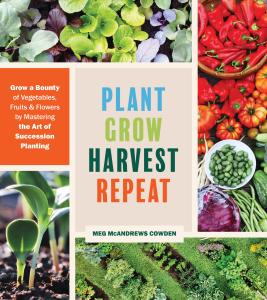
Succession planting, in different phrases, fastidiously deliberate, steady seed sowing, helps gardeners get extra out of their rising area. Plant Develop Harvest Repeat: Develop a Bounty of Greens, Fruits & Flowers by Mastering the Artwork of Succession Planting, by Meg McAndrews Cowden, attracts inspiration from succession in pure landscapes and teaches tips on how to implement classes from these dynamic methods in a house backyard to provide a gentle stream of meals.
Soar into succession planting fundamentals with some knowledge from McAndrews:

So, what’s succession planting?
Succession planting is the follow of planting crops in an deliberately staggered or timed sequence to maximise harvest.


“Within the easiest phrases, succession means one follows one other. In ecology, succession describes how plant communities develop over time, with completely different teams of vegetation succeeding each other. Plant succession encompasses a procession of life, beginning with pioneering grass species that fill in naked earth, and ultimately give solution to timber that, after millennia develop into a beloved forest… a succession backyard incorporates classes from plant communities into its very material. It dynamically emulates pure transitions throughout time. This backyard nourishes you, the gardener, for so long as is possible” (McAndrews 12-13).

What are the advantages of succession gardening?
Succession gardening lengthens the harvest season.
“Succession gardening will improve your backyard’s productiveness by maximizing the times of your rising season, even when these days are restricted, and maximizing your area, even when your backyard is small. It’s a mindset meant to have interaction your creativeness and your distinctive targets for your loved ones’s desk and gasoline your stamina for sowing all through the rising season” (McAndrews 13).

When is rising season? When is harvest season?
With succession gardening and steady planting, rising season may be year-round and the summer-fall harvest season is stretched on each ends!
“A device for all climates, steady planting turns a typical “most important season” backyard right into a spring, summer time, fall, and winter backyard. It transforms the backyard into the produce aisle, offering meals in each season. Executed nicely, steady planting produces a various array of meals all through the rising season. The backyard turns into a spot the place spring cabbages are met with early summer time cherry tomatoes, after which late-ripening peppers collides with fall apples and frost-kissed Brussel sprouts….
Whereas seed beginning (direct sowing) within the early season is simpler—cooler temperatures, fewer distractions, extra constant moisture—vegetation set up a lot sooner within the hotter months. So, whereas it feels extra arduous to sow beets within the warmth of early July, they take off extra rapidly than these transplanted below row cowl in late March. Tune in to the intricacies of your rising season and the cravings of your palate to work by these particulars” (McAndrews 28-29).

What’s interplanting?
“The head of succession planting is interplanting. This implies rising a couple of sort of vegetable or flower concurrently in the identical proximity. Additionally referred to as intercropping, and generally known as companion planting. This mingling of a couple of sort of plant in an area creates a dwelling mosaic—actually a backyard salad.
Interplanted lettuce, candy alyssum, and pink cabbage will steadily feed us and the bugs from early spring by the peak of summer time” (McAndrews 41).

Discover extra on succession gardening finest practices and detailed, seasonal sowing charts, plant profiles, and gardening suggestions in Plant Develop Harvest Repeat.

“Splendidly written, superbly illustrated, and all the pieces you could know to get extra productiveness out of your meals backyard.” —Joe Lamp’l, creator and govt producer, Rising a Greener World
Uncover tips on how to get extra out of your rising area with succession planting—fastidiously deliberate, steady seed sowing—and supply a gentle stream of contemporary meals from early spring by late fall.
Drawing inspiration from succession in pure landscapes, Meg McAndrews Cowden teaches you tips on how to implement classes from these dynamic methods in your house backyard. You’ll discover ways to layer succession throughout your perennial and annual crops; maximize the early rising season; decide the sequence to plant and replant in summer time; and incorporate annual and perennial flowers to learn wildlife and guarantee environment friendly pollination. You’ll additionally discover detailed, seasonal sowing charts to tell your backyard planning, so you possibly can develop extra wherever, no matter your local weather.
Plant Develop Harvest Repeat will encourage you to create an much more productive, lovely, and satisfying backyard throughout the seasons—each vegetable gardener’s dream.
E-newsletter Signup
By clicking ‘Signal Up,’ I acknowledge that I’ve learn and conform to Hachette Ebook Group’s Privateness Coverage
and Phrases of Use


Leave a Reply